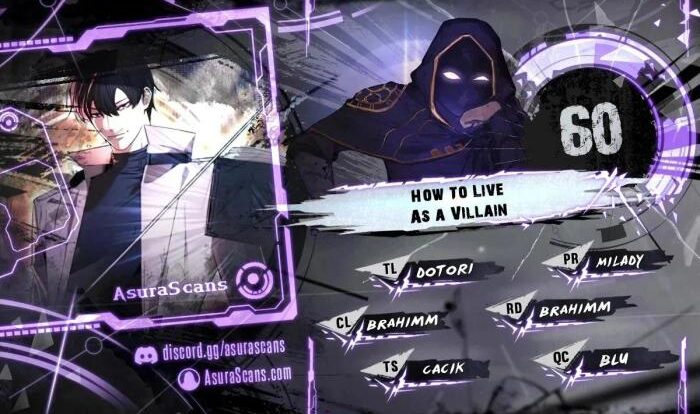
How to live as a villain ch 94 sets the stage for this enthralling narrative, offering readers a glimpse into a story that is rich in detail with gaya jurnalistik dengan tone berita and brimming with originality from the outset.
This chapter delves into the intricate psyche of the villain, exploring their motivations, tactics, relationships, lair, and nemesis, providing a comprehensive understanding of the character’s complexities and the impact they have on the story.
The chapter begins by analyzing the villain’s motivations, delving into the reasons behind their actions and exploring the backstory and experiences that shaped their worldview. It examines the psychological and emotional factors driving their villainy, providing insights into their thought processes and decision-making.
Analyzing the Villain’s Motivation
Understanding the motivations of a villain is crucial for comprehending their actions and the impact they have on the narrative. Villains are often driven by a complex interplay of factors, including personal experiences, societal influences, and psychological traits.
Backstory and Experiences
The experiences an individual has throughout their life can profoundly shape their worldview and motivations. Trauma, abuse, or neglect can lead to feelings of anger, resentment, and a desire for revenge. Conversely, positive experiences and a supportive environment can foster empathy and compassion.
Exploring the villain’s backstory provides insights into the events that shaped their personality and ultimately led them down the path of villainy.
Crafting the Villain’s Tactics

To effectively portray a compelling villain, writers must meticulously craft their tactics and strategies. The villain’s approach should align with their motivations and goals, while also creating a formidable challenge for the protagonist and other characters.
In the ongoing saga of “How to Live as a Villain” Chapter 94, the protagonist grapples with the consequences of his actions. Seeking guidance, he turns to Kings Mecconline , a renowned online resource for villains and antiheroes. As he delves into the website’s vast archives, he discovers a wealth of knowledge and strategies that will shape his path forward in Chapter 94 and beyond.
The methods employed by villains can vary widely, from psychological manipulation to physical force. Some villains rely on stealth and deception, while others embrace overt aggression. The choice of tactics depends on the villain’s personality, skills, and the context of the story.
Exploiting Vulnerabilities
One common tactic used by villains is exploiting the vulnerabilities of their opponents. They may target a character’s emotional weaknesses, such as their fears or insecurities, to manipulate them or gain control over their actions. Villains may also identify physical or situational vulnerabilities that they can exploit to their advantage.
Exploring the Villain’s Relationships
The relationships a villain forms with other characters play a crucial role in shaping their character and motivations. These interactions provide insights into the villain’s vulnerabilities, motivations, and the potential for redemption or reconciliation.
Examining the villain’s relationships with allies, rivals, and victims can reveal the dynamics that drive their actions and shape their worldview. These relationships can be sources of conflict, support, or both, influencing the villain’s choices and the trajectory of their story.
Dynamics with Allies
The villain’s relationships with their allies provide insights into their capacity for loyalty, trust, and cooperation. These allies may share similar goals or ideologies, providing the villain with support and validation. The dynamics between the villain and their allies can reveal the extent of their influence, their ability to manipulate others, and the boundaries they are willing to cross.
In the ever-evolving landscape of literary adventures, the latest chapter in the captivating tale of “How to Live as a Villain” has arrived, enthralling readers with its intricate plot and compelling characters. Chapter 94 delves deeper into the complexities of the villain’s journey, exploring the challenges and triumphs that shape their path.
As the story unfolds, readers are invited to witness the transformation of the villain, grappling with their own morality and the consequences of their actions. To delve into this captivating chapter, visit how to live as a villain ch 94 for an immersive reading experience.
- Example:In the TV series “Breaking Bad,” Walter White’s alliance with Jesse Pinkman demonstrates the complexities of a villain’s relationships. Their partnership is built on shared desperation and ambition, but it is also fraught with conflict and mistrust.
Conflicts with Rivals
The villain’s interactions with their rivals provide a stage for testing their strength, intelligence, and resolve. These conflicts can be personal, ideological, or a combination of both. By analyzing the nature of these conflicts, we can gain insights into the villain’s motivations, their vulnerabilities, and the potential for their downfall.
- Example:In the film “The Dark Knight,” the rivalry between Batman and the Joker highlights the clash between order and chaos. Their interactions showcase the Joker’s twisted worldview and Batman’s unwavering commitment to justice.
Interactions with Victims
The villain’s relationships with their victims offer a glimpse into their capacity for empathy, remorse, and the consequences of their actions. These interactions can reveal the extent of the villain’s cruelty, their justifications for their behavior, and the potential for redemption or reconciliation.
How to live as a villain ch 94 explores the journey of a character navigating the complexities of morality and power. The chapter delves into the protagonist’s struggles as they grapple with the consequences of their actions and the weight of their choices.
As the story unfolds, the reader is taken on a captivating adventure that delves into the dark side of humanity and the challenges of living as a villain. For more insights into this compelling narrative, visit how to live as a villain ch 94 to continue reading.
- Example:In the novel “Les Misérables,” the relationship between Jean Valjean and Inspector Javert explores the complexities of redemption and forgiveness. Javert’s relentless pursuit of Valjean highlights the consequences of the villain’s past actions and the possibility of a second chance.
Building the Villain’s Lair
The villain’s lair is not merely a hideout; it is an extension of their malevolent persona, a physical manifestation of their twisted desires and evil intentions. The setting and environment of the lair play a crucial role in shaping the villain’s character and motivations.
The lair’s location often reflects the villain’s personality. Some villains prefer secluded, isolated lairs hidden deep within remote forests or abandoned warehouses, while others revel in the chaos of urban landscapes, establishing their lairs in the heart of bustling cities.
Symbolism and Functionality
The lair’s architecture and design are carefully crafted to symbolize the villain’s power and dominance. Gothic spires and menacing gargoyles may adorn the exterior, while the interior is often a labyrinth of dark corridors and hidden chambers. These elements serve to intimidate and disorient intruders, reinforcing the villain’s sense of control.
The lair also serves as a functional base of operations for the villain’s nefarious activities. It may house laboratories for conducting sinister experiments, torture chambers for extracting information from captives, and arsenals for storing weapons and other tools of destruction.
Reflection of the Villain’s Personality and Goals
The lair provides a glimpse into the villain’s psyche. The choice of decor, lighting, and even the air quality can reveal the villain’s personality traits and motivations. A lair adorned with opulent furnishings and flickering candles may indicate a villain with a taste for luxury and extravagance, while a lair filled with skulls and bones suggests a villain with a morbid fascination with death.
How to Live as a Villain Chapter 94 offers an intriguing glimpse into the life of a villainous protagonist. The chapter delves into the complex motivations and actions of the character, providing readers with a nuanced perspective on the nature of villainy.
As the story unfolds, the protagonist’s journey becomes more captivating, leaving readers eager to discover the outcome of their treacherous path. How to Live as a Villain Ch 94 explores the moral complexities of villainy, challenging readers to question their own perceptions of right and wrong.
The lair’s design also reflects the villain’s goals. A lair with multiple escape routes and secret passages may belong to a villain who values their freedom and is always prepared to flee, while a lair with a central throne room and a grand staircase may be the abode of a villain who craves power and recognition.
In the latest installment of the popular web novel, “How to Live as a Villain,” chapter 94 explores the complexities of navigating a treacherous world. As the protagonist, Lucius, faces new challenges and confronts his own inner demons, readers are captivated by the intricate plot and nuanced character development.
Follow Lucius’ journey in chapter 94 as he grapples with the consequences of his actions and the weight of his destiny.
Developing the Villain’s Nemesis
Identifying and developing the villain’s nemesis is crucial for creating a compelling narrative. The nemesis represents the opposing force that challenges the villain’s plans and drives the conflict forward.
Identifying the Nemesis
The nemesis can be a protagonist, an antagonist, or even a non-human entity that directly opposes the villain’s goals. The key characteristic is that the nemesis possesses the motivation and abilities to thwart the villain’s schemes.
Motivations and Abilities
The nemesis’s motivations can range from a personal vendetta to a broader moral or ideological conflict. Their abilities should complement the villain’s strengths and weaknesses, creating a dynamic and engaging rivalry.
Conflict and Rivalry, How to live as a villain ch 94
The conflict between the villain and the nemesis forms the backbone of the narrative. It should be intense, escalating in both stakes and emotional intensity as the story progresses. The rivalry between the two characters should be complex, with each side having their own strengths and vulnerabilities.
Ultimate Conclusion: How To Live As A Villain Ch 94
In conclusion, how to live as a villain ch 94 offers a captivating exploration of the villain’s character, providing a nuanced understanding of their motivations, tactics, relationships, lair, and nemesis. Through this comprehensive analysis, the chapter enhances the reader’s appreciation of the villain’s role in the story and deepens their understanding of the complex dynamics at play.
FAQ Explained
What is the significance of the villain’s lair?
The villain’s lair serves as a physical manifestation of their personality and goals, reflecting their inner workings and providing insights into their character.
How does the villain’s nemesis contribute to the story?
The nemesis provides a counterpoint to the villain, highlighting their flaws and weaknesses while driving the conflict and tension of the narrative.
What is the purpose of analyzing the villain’s motivations?
Understanding the villain’s motivations helps readers comprehend their actions and decisions, making their character more relatable and the story more engaging.





